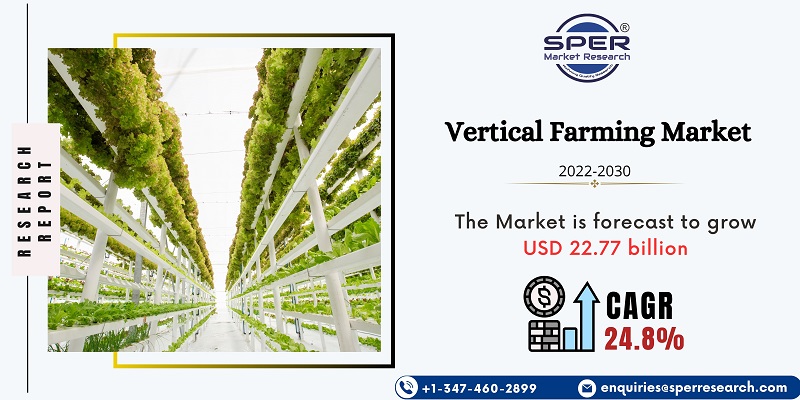
Vertical Farming Market Growth, Trends, Size, Revenue, Demand, Challenges and Future Outlook
Vertical Farming Market Size - By Component, By Structure, By Growth Mechanism - Regional Outlook, Competitive Strategies and Segment Forecasts to 2030
| Published: Nov-2022 | Report ID: AGRI2205 | Pages: 1 - 256 | Formats*: |
| Category : Agriculture | |||
- Increased consumer demand for organic products, spurred by a greater standard of living and more disposable income, cleared the path for the development of vertical farming, where organic farming is commonly practised. People are cultivating the necessary crops on a modest scale in their own homes in order to obtain pest-free meals.
- Vertical farming addresses the growing concerns over food security by offering a sustainable solution to produce fresh food in urban areas. As the global population continues to grow, vertical farming provides a means to produce food locally and reduce reliance on traditional agricultural methods.
-010182623082023.jpg)

| Report Metric | Details |
| Market size available for years | 2019-2030 |
| Base year considered | 2021 |
| Forecast period | 2022-2030 |
| Segments covered | By Component, By Structure, By Growth Mechanism |
| Geographies covered | North America, Asia-Pacific, Latin America, Middle East & Africa and Europe. |
| Companies Covered | Altius Farms, BrightFarms Inc., Green Sense Farms, LLC, Vertical Farm Systems, Freight Farms, Future Crops, Illumitex, Inc., Agrilution GmbH, GrowUp Urban Farms Ltd., American Hydroponics, Everlight Electronics Co., Ltd., AeroFarms, Others. |
- Agricultural and Food Industry Players
- Consumers
- Investors and Financial Institutions
- Restaurant Chains and Catering Companies
- Technology and Equipment Suppliers
- Urban Developers and Real Estate Companies
- Others
| By Component |
|
| By Structure |
|
| By Growth Mechanism |
|
- Global Vertical Farming Market Size (FY’2022-FY’2030)
- Overview of Global Vertical Farming Market
- Segmentation of Global Vertical Farming Market By Component (Glass greenhouse, Plastic greenhouse, Others)
- Segmentation of Global Vertical Farming Market By Structure (Container-based Vertical Farms, Building-based Vertical Farms)
- Segmentation of Global Vertical Farming Market By Growth Mechanism (Hydroponics, Aeroponics, Aquaponics)
- Statistical Snap of Global Vertical Farming Market
- Expansion Analysis of Global Vertical Farming Market
- Problems and Obstacles in Global Vertical Farming Market
- Competitive Landscape in the Global Vertical Farming Market
- Impact of COVID-19 and Demonetization on Global Vertical Farming Market
- Details on Current Investment in Global Vertical Farming Market
- Competitive Analysis of Global Vertical Farming Market
- Vital Players in the Global Vertical Farming Market
- SWOT Analysis of Global Vertical Farming Market
- Global Vertical Farming Market Future Outlook and Projections (FY’2022-FY’2030)
- Recommendations from Analyst
1.1. Scope of the report1.2. Market segment analysis
2.1 Research data source
2.1.1 Secondary data2.1.2 Primary data2.1.3 SPER’s internal database2.1.4 Premium insight from KOL’s
2.2 Market size estimation
2.2.1 Top-down and Bottom-up approach
2.3 Data triangulation
4.1. Driver, Restraint, Opportunity and Challenges analysis
4.1.1 Drivers4.1.2 Restraints4.1.3 Opportunities4.1.4 Challenges
4.2. COVID-19 Impacts of the Global Vertical Farming Market
5.1. SWOT analysis
5.1.1 Strengths5.1.2 Weaknesses5.1.3 Opportunities5.1.4 Threats
5.2. PESTEL analysis
5.2.1 Political landscape5.2.2 Economic landscape5.2.3 Social landscape5.2.4 Technological landscape5.2.5 Environmental landscape5.2.6 Legal landscape
5.3. PORTER’S five forces analysis
5.3.1 Bargaining power of suppliers5.3.2 Bargaining power of Buyers5.3.3 Threat of Substitute5.3.4 Threat of new entrant5.3.5 Competitive rivalry
5.4. Heat map analysis
6.1. Irrigation Component6.2. Lighting6.3. Sensor6.4. Climate Control6.5. Building Material
6.5.1. Glass greenhouse6.5.2. Plastic greenhouse
6.6. Others
7.1. Building-based Vertical Farms7.2. Container-based Vertical Farms
8.1. Hydroponics8.2. Aeroponics8.3. Aquaponics
9.1 North America
9.1.1. United States9.1.2. Canada9.1.3. Mexico
9.2 Europe
9.2.1. Germany9.2.2. United Kingdom9.2.3. France9.2.4. Italy9.2.5. Spain9.2.6. Rest of Europe
9.3 Asia-Pacific
9.3.1. China9.3.2. Japan9.3.3. India9.3.4. Australia9.3.5. South Korea9.3.6. Rest of Asia-Pacific
9.4 South America
9.4.1. Brazil9.4.2. Argentina9.4.3. Rest of South America
9.5 Middle East & Africa
9.5.1. Kingdom of Saudi Arabia9.5.2. United Arab Emirates9.5.3. Rest of Middle East & Africa
10.1.1. Company details10.1.2. Financial outlook10.1.3. Product summary10.1.4. Recent developments
10.2.1. Company details10.2.2. Financial outlook12.2.1. Product summary12.2.2. Recent developments
10.3.1. Company details10.3.2. Financial outlook10.3.3. Product summary10.3.4. Recent developments
10.4.1. Company details10.4.2. Financial outlook10.4.3. Product summary10.4.4. Recent developments
10.5.1. Company details10.3.2. Financial outlook10.3.3. Product summary10.3.4. Recent developments
10.6.1. Company details10.6.2. Financial outlook10.6.3. Product summary10.6.4. Recent developments
10.7.1. Company details10.7.2. Financial outlook10.7.3. Product summary10.7.4. Recent developments
10.8.1. Company details10.8.2. Financial outlook10.8.3. Product summary10.8.4. Recent developments
10.9.1. Company details10.9.2. Financial outlook10.9.3. Product summary10.9.4. Recent developments
10.10.1. Company details10.10.2. Financial outlook10.10.3. Product summary10.10.4. Recent developments
10.11.1. Company details10.11.2. Financial outlook10.11.3. Product summary10.11.4. Recent developments
10.12.1. Company details10.12.2. Financial outlook10.12.3. Product summary10.12.4. Recent developments
SPER Market Research’s methodology uses great emphasis on primary research to ensure that the market intelligence insights are up to date, reliable and accurate. Primary interviews are done with players involved in each phase of a supply chain to analyze the market forecasting. The secondary research method is used to help you fully understand how the future markets and the spending patterns look likes.
The report is based on in-depth qualitative and quantitative analysis of the Product Market. The quantitative analysis involves the application of various projection and sampling techniques. The qualitative analysis involves primary interviews, surveys, and vendor briefings. The data gathered as a result of these processes are validated through experts opinion. Our research methodology entails an ideal mixture of primary and secondary initiatives.



Frequently Asked Questions About This Report
PLACE AN ORDER
Year End Discount
Sample Report
Pre-Purchase Inquiry
NEED CUSTOMIZATION?
Request CustomizationCALL OR EMAIL US
100% Secure Payment






Related Reports
Our Global Clients
Our data-driven insights have influenced the strategy of 200+ reputed companies across the globe.




















